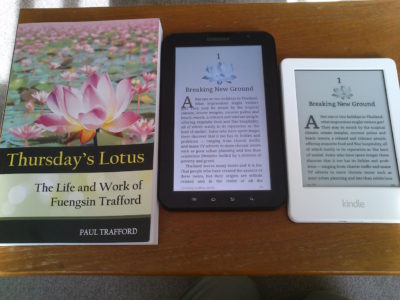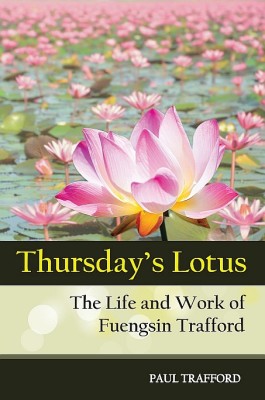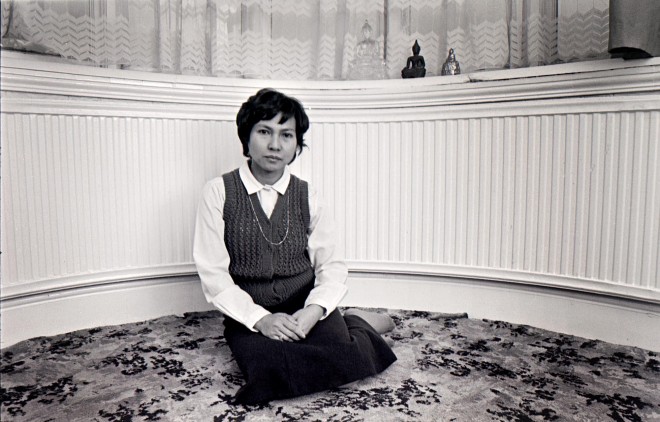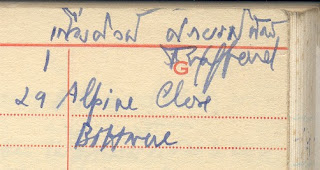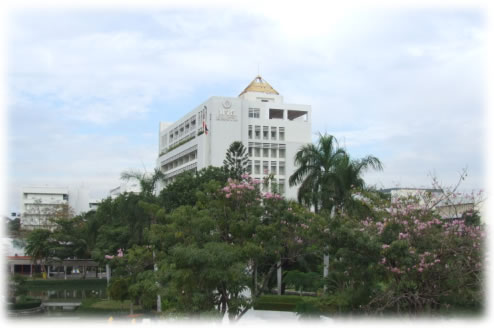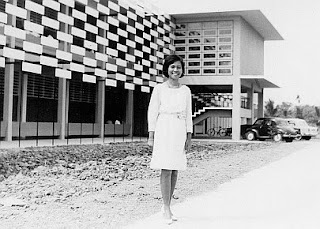Note
The following is a copy of an article I
originally posted on Blogger.com, December 30,
2009:
https://paultrafford.blogspot.co.uk/2009/12/recalling-memories-through-pictures.html
The processes of contact, feelings, perception
and memory are closely interlinked. They are
mediated through our senses and for most people the
sense that usually predominates is sight. So in
trying to put together the early life of my mother,
the late Fuengsin Trafford, it’s been helpful to
carry out interviews based on sets of photographs.
I haven’t done much planning really, but rather
have made things up as I’ve gone along, working
intuitively; it’s only now I can see more of the
methodology that I’ve actually followed! I’ll
report here on that methodology and also on some of
the technical tools that I’ve used to assist
me.
My mother left hundreds of photos, which I’ve
tried to arrange in sets according to distinct
periods: early childhood, University days, her
first years of teaching and so on. I created an
index for each set and have pencilled in an
incrementing number on the back of each photo, so
that they are uniquely identified and there’s some
order to them, though (as I later would frequently
find out) it’s not chronological! I then scanned in
the photos at a fairly high resolution (on an HP
Scanjet 5370C, quite old now) and saved the files
using the index as part of the file name. Having
done this for a fair proportion of the collection,
I’ve put copies in many places – on laptop hard
drives, an external backup disk and memory
sticks.
However, merely creating an archive without any
descriptions is not much use! For some while I had
intended to ask relatives and friends of my mother
to enlighten me as to the context and details
concerning the photos. I was finally able to set
off for my mini fieldwork earlier this month
(December), with a copy of the photos on my
netbook, an Eee PC. When I met the ‘interviewees’
in Thailand I recorded the conversations using a
digital voice recorder, saving copies of the
recordings as files on the netbook.
It was the first time I had properly used such a
recording device and my experience of conducting
interviews was minimal (though I once did an
interview with a Big Issue seller as part of a one
day digital video course). So earlier this year I
explored the world of digital audio recorders (a
process that’s familiar for me as I’ve purchased
quite a lot of electronic devices 🙂 I settled on an
Olympus WS-110, which is a compact device, somewhat
smaller and lighter than e.g. a Nokia 8210 mobile
phone. I chose it based on reviews of its audio
quality – good microphone and high quality sampling
(see e.g. reviews
on Amazon); file format wasn’t a concern for
me. These devices are evolving rapidly and already
Olympus lists this as an archived product, which
means you should be able to find it new at a very
good price on ebay (which is where I purchased it).
Operating the device was very simple.
Then the netbook would serve as a digital
lightbox and a basic means of navigation – for a
given photo set all the photos would be the same
folder and I’d run a slideshow using the
wonderful Irfanview! The
major handicap with the netbook is the relatively
small screen – in many cases I needed to zoom in
(my audio recording has a lot of tapping sounds!)
When I was in conversation, I’d start with a
preamble about what I was intending to do and asked
for permission (it’s worth confirming this
afterwards as well). Although sometimes you know
that everyone is happy, it’s a good habit to get
into in case I go on to do academic fieldwork,
which is something I am deliberating. My main role
felt like being a catalyst, with some general
encouragement and a few questions sprinkled here
and there, to elicit a few more details. There’s no
doubt a large swathe of literature on conducting
such interviews, but I didn’t read any.
On my return to the UK it was time to transcribe
what had been said. To facilitate this, I wanted to
associate the audio with the respective pictures (a
tradeoff of using a separate recording device
rather than doing the recording directly on the
netbook). The intended result would be a video
consisting of the photos that I had shown with each
photo accompanied by the respective audio
commentary, i.e. the comments from friends and
relatives.
The solution I adopted was to use a video
editing tool, Windows Movie Maker (WMM for short),
which comes part of the Windows operating system. I
guess it is similar in functionality, if not in
elegance, with Apple’s iMovie. My familiarity with
WMM is very limited, so it’s probably best if I
summarise. The basic idea is to create one WMM file
for each interview (WMM only provides a single
audio track) so that in any given interview when
playing back you know what was said about a
particular picture. Here’s a screenshot:
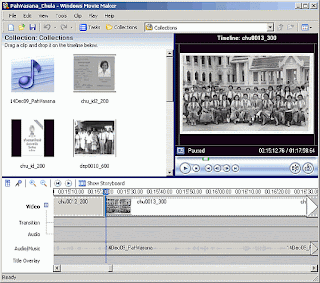
There are basically three areas: top left is the
collection of files that I used to create the
composition – this is where you import the photos
and the audio and in this case I could import audio
straightaway without conversion as it was in WMA
format. Top right is the playback for the
composition as a whole. However, the work is
carried out below in the storyboard/timeline, which
consists of parallel tracks. All I used was the
Video and Audio tracks, dragging and dropping
photos from the collection area, moving them about
until there was approximate synchronisation.
However, in writing a
biography I need words as well as pictures! The
next step in the process is
thus transcription. The method I’m
using here is to create a large table with the
first column containing the photos, one photo per
row. Each of the other columns are to record the
transcription from a particular interview. With
reference to the WMM files I’m transcribing what
was said about a particular photo in the
corresponding cell of the table. Again I’m not
being particularly sophisticated about the
implementation – it’s one mammoth table in a MS
Word document. As long as it works, it is okay. For
a formal research project I expect this would be
better implemented in a database.
Handwriting bonus!
There have been some nice extras in undertaking
this exercise. My mother has penned in Thai many
documents, including a diary over several years.
It’s one thing to learn how to read the printed
word, but a further step to decipher Thai
handwriting! With these compositions I have some
samples here that have been read out (and with the
aid of a dictionary I can slowly spell them out
myself). To be systematic, for each letter I can
build up a set of samples that I can use later
on.
For a few hours of recording, there are many
more in organising and interpreting, but I find it
fun to do and along the way I learn a little more
about Thai history generally. For anyone
contemplating learning more about their own family
history, I’d recommend this as a stimulating and
informative exercise.
Acknowledgements
I mustn’t forget to thank everyone who has
kindly provided information in the December
interviews, including: Pah Vasana, Khun Jamras, Pah
Umpai, P’ Laem, P’ Darunee & her mother, Khun
Chaiwat, P’ Yui, P’ Ead, Na Tewee, Na Tun, and Pah
Jah. If I could contact all those my mother knew
well, this list would be very long …

